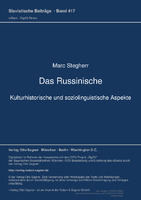Das Russinische
Kulturhistorische und soziolinguistische Aspekte
| dc.contributor.author | Stegherr, Marc | |
| dc.date.accessioned | 2019-01-10 23:55 | |
| dc.date.accessioned | 2020-01-09 14:44:01 | |
| dc.date.accessioned | 2020-04-01T11:01:16Z | |
| dc.date.available | 2020-04-01T11:01:16Z | |
| dc.date.issued | 2003 | |
| dc.identifier | 1003948 | |
| dc.identifier | OCN: 1083000734 | en_US |
| dc.identifier.uri | http://library.oapen.org/handle/20.500.12657/26139 | |
| dc.description.abstract | The concerns not only of the Slavic minorities are gaining in significance with the forthcoming eastward enlargement of the European Union. The Russians or Ruthenians are a Slavic ethnic group, which is mainly located in the Carpathian region as a border area between Poland, Hungary, Slovakia and Ukraine, an excellent example of this, as their culture and language not only in a historical and religious, but also developed in a linguistic border or transition area. Only at the turn of the last century did they succeed in gaining greater attention for their language and culture. In the course of the last century, the development of their language has fluctuated regionally between oppression and normalization / codification. This was accompanied by the weakening or strengthening of Russian identity, which experienced an unexpected boom at the end of the 20th century after the end of the communist regime. | |
| dc.language | German | |
| dc.relation.ispartofseries | Slavistische Beitraege | |
| dc.subject.classification | thema EDItEUR::C Language and Linguistics | en_US |
| dc.subject.classification | thema EDItEUR::N History and Archaeology::NH History | en_US |
| dc.subject.other | culture | |
| dc.subject.other | history | |
| dc.subject.other | language | |
| dc.subject.other | Aspekte | |
| dc.subject.other | Die Geschichte der jugoslavischen Russinen | |
| dc.subject.other | Die Normen des Vojvodina-Russinischer | |
| dc.subject.other | Herkunft der Russinen | |
| dc.subject.other | Kulturhistorische | |
| dc.subject.other | Normicrungsvcrsuche des Karpato-Russinischer | |
| dc.subject.other | Russinische | |
| dc.subject.other | soziales Leben der Karpato-Russinen | |
| dc.subject.other | soziolinguistische | |
| dc.subject.other | Stegherr | |
| dc.title | Das Russinische | |
| dc.title.alternative | Kulturhistorische und soziolinguistische Aspekte | |
| dc.type | book | |
| oapen.abstract.otherlanguage | Die Anliegen nicht nur der slavischen Minderheiten gewinnen mit der bevorstehenden Osterweiterung der Europäischen Union an Bedeutung. Die Russinen oder Ruthenen sind als slavische Volksgruppe,die vor allem im Karpatenraum als Grenzgebiet zwischen Polen, Ungarn, der Slowakei und der Ukraine beheimatet ist, ein hervorragendes Beispiel dafür, da sich ihre Kultur und Sprache nicht nur in einem historischen und religiösen, sondern auch in einem sprachlichen Grenz- bzw. Übergangsgebiet entwickelt hat. Erst um die vorletzte Jahrhundertwende gelang es ihnen, ihrer Sprache und Kultur größere Aufmerksamkeit zu verschaffen. Im Laufe des letzten Jahrhunderts schwankte die Entfaltung ihrer Sprache regional zwischen Unterdrückung und Normierung/Kodifizierung. Damit einher ging die Schwächung bzw. Stärkung russinischer Identität, die am Ende des 20. Jahrhunderts nach dem Ende der kommunistischen Regime eine unerwartete Blüte erlebte. | |
| oapen.identifier.doi | 10.3726/b12692 | |
| oapen.relation.isPublishedBy | e927e604-2954-4bf6-826b-d5ecb47c6555 | |
| oapen.relation.isbn | 9783954790265 | |
| oapen.series.number | 417 | |
| oapen.pages | 541 | |
| oapen.place.publication | Bern | |
| oapen.identifier.ocn | 1083000734 |

